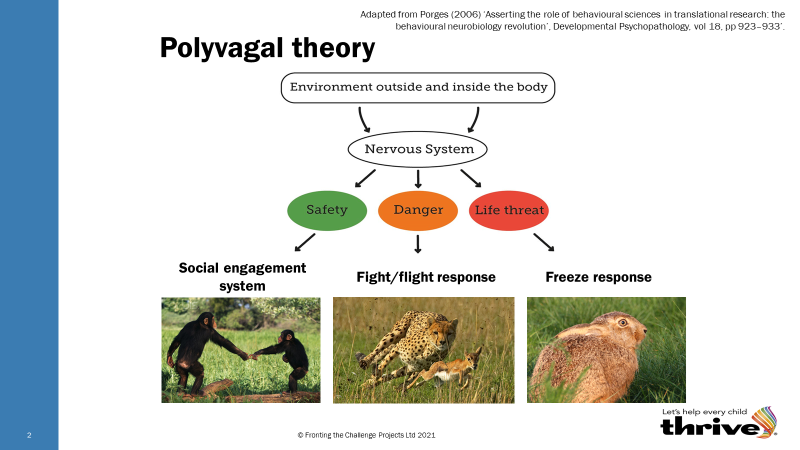Part 3 - Building emotional safety
Safety IS the treatment. - Stephen W Porges
What is emotional safety?
Emotional safety means that you feel safe enough to be vulnerable and express your feelings, both to yourself and to another person.
Children who feel ashamed or too intimidated to talk about their feelings can be filled with self-doubt and this can cause embarrassment and frustration, which can have a strong impact on their learning.
Emotional safety and behaviour
Dr Stephen Porges’ 1 Polyvagal Theory has shown that feeling safe is dependent on our nervous system and the cues it picks up.
If you feel safe, your nervous system will allow you to connect and build trusting relationships.
However, if your nervous system picks up cues of danger2 it will cause the brain to react defensively. This triggers a fight or flight reaction or freeze response and can lead to dysregulated and withdrawn behaviour.
It is useful for adults working with children and young people to explore, not only how to create cues of safety for their pupils, but possible triggers that cause distressed behaviours. Understanding your own triggers will also help you to respond effectively to your pupils, as it is only when you are feeling calm that you can support others through co-regulation.
The image below summarises the three pathways our nervous system could take depending on the cues it picks up.

Window of Tolerance
Dr Dan Siegel3 developed the window of tolerance to show the optimal zone of ‘arousal’ for a person in everyday life. In this zone, you are in an emotionally safe space; you can perform everyday tasks, manage your emotions and engage with those around you.
If you enter hyper-arousal, caused by triggers or stressors that set off a fight or flight response, you may see more aggressive behaviours, or blame as a natural reaction. People in this area can present as angry, anxious, overwhelmed, and chaotic.
Entering hypo-arousal results in a freeze response where the body starts to shut down and disassociate. People in this area can feel depressed, numb and withdrawn and may even lose the ability to speak.
The video below explains the window of tolerance and what happens when people leave their optimal zone. As well as what happens when the window shrinks due to traumatic or negative experiences. This is useful to know as an adult who works with children and young people, as every child will have a different size window of tolerance.
As the video illustrates there are also ways to grow people’s window of tolerance, so they feel safe and regulated for longer.
Creating emotional safety
There are activities you can do to regulate your feelings and behaviours to get yourself back to a calm and emotionally safe space.
When a fight or flight response is triggered, it can help to focus on your breathing - yoga, mindfulness and meditation are all good strategies to ground yourself and bring you back down to your safe zone.
When you are frozen and disassociated, any activity that can bring you back into the present while stimulating your senses will help bring you back to your safe zone. For example, exercise, smelling essential oils, playing music and simple cognitive tasks for example- look left and name 3 things.
As an adult there are ways you can create emotional safety for children:
- Take the time to listen to their feelings - acknowledging their experiences and feelings while helping them work through them.
- Try to connect and get to know the child - doing this will show you care and strengthen the relationship you have.
- Model positive behaviours - be consistent in your behaviour and attitude towards students and ensure you are positive to avoid making them feel alienated. Modelling positive behaviours will help students learn from your example.
Emotional Safety and the Thrive Approach
The Thrive Approach is underpinned by neuroscience, child development theory and attachment theory.
Using these three theories, Thrive training provides you with the tools, knowledge and resources to be able to spot which children and young people are struggling with their emotional safety. This enables you to build secure relationships with them and help them feel safe at school, which will have a positive impact on their emotional wellbeing.
Thrive trains you to help meet children and young people’s needs at the right stage of development or use activities to make up for missed development. It builds upon the window of tolerance and polyvagal theory, helping you enable your pupils to become emotionally resilient to life’s ups and downs.
References
- Dr Stephen Porges is a distinguished scientist at the Kinsey Institute at Indiana University Bloomington and a research professor in the Department of Psychiatry at the University of North Carolina at Chapel Hill. Read the first chapter of The Pocket Guide to Polyvagal Theory here.
- Read a preview of Dr Stephen Porges's The Polyvagal Theory Neurophysiological Foundations of Emotions, Attachment, Communication, and Self-regulation.
- Dr Dan Siegel is a Clinical Professor of Psychiatry at the UCLA School of Medicine and the founding co-director of the Mindful Awareness Research Center at UCLA. View his window of tolerance here.
